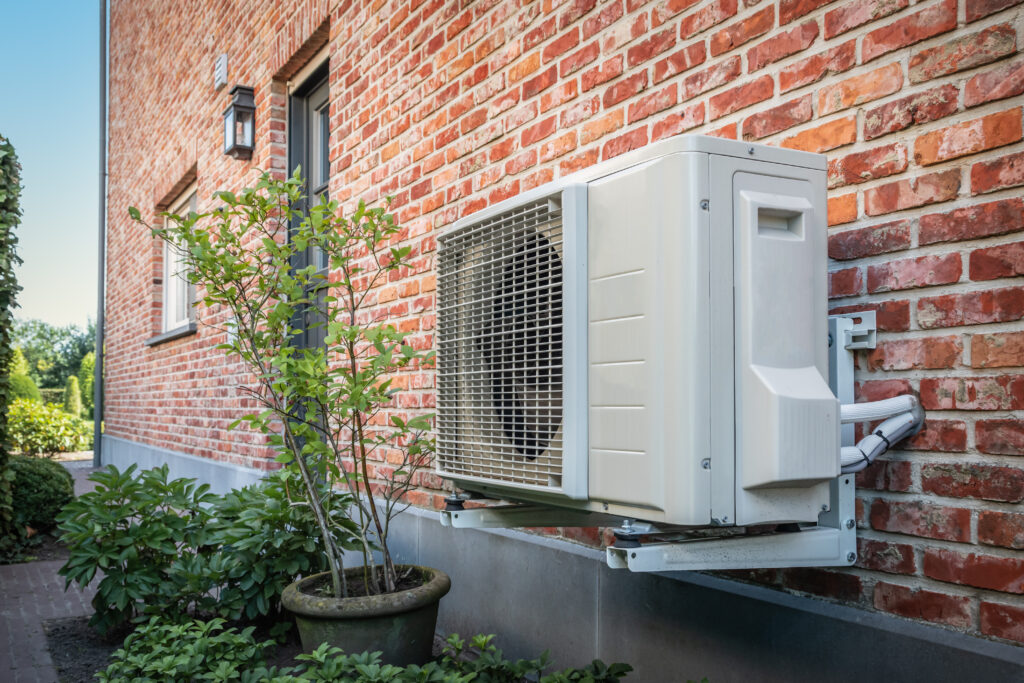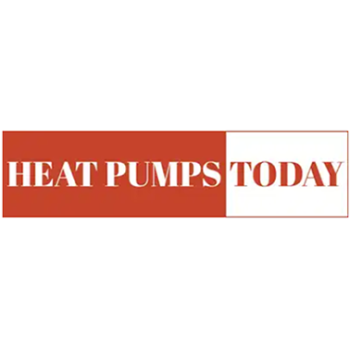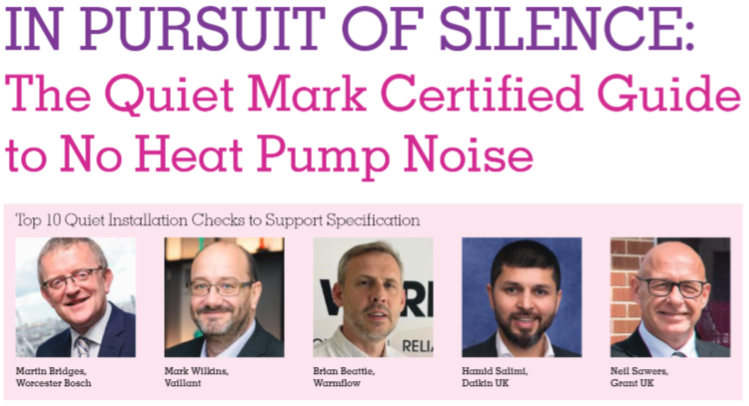

As the demand for low to no-noise from heat pumps by consumers and trade increases, innovative design and supporting installation is now fundamental to grow contracts.
Drawing on the knowledge of the industry’s technical experts from five Quiet Mark Certified heat pump manufacturers, this article [originally published in Heat Pumps Today Aug/Sept 2023 Issue] focuses on the vital area of sound design to boost installation knowhow.

Quiet Mark certified heat pumps, both air source and ground source from leading manufacturers have been assessed on a like for like basis and have all achieved lowest noise levels out of marketwide comparisons. Born of UK’s Noise Abatement Society charitable foundation Quiet Mark serves the same remit as the charity to abate excessive noise to support public health.
Setting the scene Martyn Bridges, Director of Technical Services at Worcester Bosch shares “it is first important to differentiate between the two most common types of heat pumps installed in UK properties.
Ground source heat pumps use a collection loop buried in the ground to heat up the refrigerant within the heat pump itself, whereby an air source heat pump uses a fan to draw air through the externally sited heat pump. As a result, it is quite rare to receive any noise complaints from a ground-source heat pump. The very small number of issues people have with noise volumes are typically associated with an air source heat pump. These issues generally stem from the fan, compressor and quite often a circulation pump.
However, at the moment they are mostly “one off” houses where they are installed rather than an estate or road of houses all having Heat pumps and as a result, are unlikely to cause any great concerns.
Air source heat pumps are a very quiet form of home heating. Homeowners & installers should look for heat pumps which are Quiet Mark approved which means they have industry leading levels of low noise when in operation.
Neil Sawers, Commercial Technical Manager at Grant UK adds “while the fan creates some noise, they are, in general, very quiet. It is actually from the compressor which generates lower frequencies and these are ‘easier’ to hear. That said, steps are taken to reduce this noise and the vibration transferred through the structure of the heat pump to minimise any impact on the end-user.
Air source heat pumps are outdoor units so when they are sited, it is important to factor in both the homeowner’s preferences and any neighbouring properties. A correctly installed heat pump will not create significant noise, but it may be preferable to install the unit away from outdoor seating areas or away from windows of regularly occupied living areas within the home. It should not be sited too closely to a property’s boundary with another property either – Building Regulations state that a heat pump cannot be installed within 1metre of the boundary of the curtilage of a property.
Mark Wilkins, Technologies and Training Director at Vaillant says “when it comes to system design, installers can look to further minimise the noise impact for homeowners by addressing factors such as the installation site, clearance surrounding the unit, and any materials or structures which may cause noise to be reflected. To reassure homeowners even more, MCS accredited installers can also carry out a Noise Impact Assessment ahead of installation to establish the ideal location for the heat pump to be sited, further minimising sound levels of the unit.”
Hamid Salimi, Product Manager – Residential, Daikin UK "an MCS020 noise assessment is carried out by the installer as part of permitted development. Also, correct sizing and siting of the outdoor unit will reduce sound."
Neil Sawers, at Grant UK “The planning and design of an air source heat pump system is crucial. A correctly sized and designed system will not only be more efficient, but it will also ensure that all the correct installation protocols are adhered to, which in turn will help minimise sound levels. A heat pump should not be installed on unlevel surfaces such as gravel, grass or shingle – instead, a sound, level foundation must be laid. The base needs to be firm and flat so that it is capable of supporting the weight of the heat pump while also reducing the transmission of noise and vibration.
Suitable bases include a flat trowelled concrete base which is 150mm thick or paving slabs laid on compacted hard core laid to a sufficient depth for the ground conditions. To further minimise vibration within the heat pump and the transmission of vibration into the ground, we recommend that a heat pump should be raised up from the base surface by approximately 100mm.
Mark Wilkins at Vaillant “For homeowners considering a heat pump as their heating technology of choice, noise can be an important factor. For consumers, Quiet Mark provides a definitive guide when it comes to measuring sound, allowing for easy identification of the quietest, high performance products on the market.
Brian Beattie, WarmFlow “Noise is assessed with a decimal metre directly beside the heat pump, this more than sufficient as most homeowners will not be that close to the outdoor unit. Most market leading Heatpumps have then been secondary assessed and received the Quiet Mark stamp of approval which is only available to heat pumps with low levels of noise operation.
Hamid Salimi, Daikin UK “There is a noise assessment by MCS called MCS020, which is part of permitted development rights. This assessment is quite thorough. It ensures that the outdoor unit is quiet enough so that it doesn’t make noise when heard from the assessment position. This position is 1m away from a habitable room at the neighbouring property.
Neil Sawers, at Grant UK: Air source heat pump models undergo a wide range of assessments prior to being made available in the marketplace, testing their efficiencies through to sound levels. Here in the UK, heat pump manufacturers are required to test their heat pumps’ sound levels in accordance with BS EN ISO 3743-1:2010. The outcome of the test produces a weighted sound power level dB(A) that can be used to calculate the pressure level depending on the number of reflective surfaces within 1 metre of the heat pump and the distance the heat pump is from the assessment position (usually the closest, habitable room window of the neighbouring property).
The Town and Country Planning Act (1990) has set a maximum noise pressure level at the assessment position of 42d(B)A, irrespective of the distance to the heat pump. This number seems to work well in the majority of installations although it is difficult for the installer to actually measure this.
Neil Sawers, at Grant UK: We always recommend that installers thoroughly discuss the final position of a heat pump with their customer, whether they be the homeowner or developer, to ensure that any potential nuisance factors are considered and avoided. A lot of customers prefer to have their heat pump located as discreetly as possible (for aesthetic, acoustic or other reasons) and this may include keeping the unit out of areas where children play, sitting it away from opening windows and doors or locating a heat pump away from entertainment spaces within the garden.
Every installation is different and not all properties will have a choice when it comes to finding the most suitable location to site a heat pump, but it is always worth discussing the possibilities available. For example; a heat pump does not have to be positioned next to a wall of the house but instead an out-building may be more suitable, provided the necessary pipework can be accommodated.
Brian Beattie, WarmFlow: With Quiet Mark approved heat pumps, due to their low-level noise operation do not require additional acoustic insulation.
Neil Sawers, at Grant UK: Installing a low-noise heat pump model has several advantages. Firstly, developers, specifiers and installers can be assured that they are providing their customers with a product that has been thoroughly tested to prove its quietness and low sound levels. Secondly, it can open up the scope for the range of applications suitable for a heat pump installation. For a heat pump to achieve MCS certification, it must adhere to minimal sound characteristic standards amongst other criteria. Heat pumps which are not MCS approved are not eligible for installation through the Government’s Boiler Upgrade Scheme which is a source of funding available to eligible homeowners in the retrofit market.
Martyn Bridges, Worcester Bosch: As the volume of heat pumps in use increases the government has been doing some work on whether their noise level is indeed an issue and whether tools are available to dispel noise with a report on the topic expected this summer. Worcester Bosch is a good example in this regard as you can fit a sound diffuser to our heat pumps which will take approximately 4 dBA of the noise level. If this isn’t sufficient there is a further sound insulating hood you can fit as an accessory. However, this may not be the case with all heat pumps, and that’s why it’s worth selecting a heat pump with the optional accessories that can reduce its sound level.
Neil Sawers, at Grant UK: The key measures to take to reduce heat pump noise include: choosing an appropriate location to site the heat pump, laying a suitable foundation for the heat pump to be installed upon, fitting the heat pump onto suitable anti-vibration feet or mounting blocks, and ensuring the heat pump is set up, commissioned and maintained correctly. Calculate the potential noise level as previously mentioned and use screening to help reduce the noise level further.
Brian Beattie, WarmFlow: Once a heat pump is installed, it is very difficult to reduce the noise without major reworking. If the heat pump needs to be relocated, it requires pipes, electrics and drainage to be relocated. This can be a major undertaking and can cost close to the original installation cost.
Martyn Bridges, Worcester Bosch: When the air temperature drops, and more heat is required, the noise coming from the heat pump’s compressor and fan may increase, as they both will have to work harder.
Neil Sawers, at Grant UK: If the recommended installation protocols are not followed and the heat pump becomes noisy as a result, correcting these installation errors can be costly and time consuming. For example; if an inadequate base is prepared for the heat pump, the heat pump will have to be temporarily disconnected from the system, the existing base either removed entirely or enhanced, with a suitable replacement base put in its place. This not only causes disruption to the end-user but it is not the best use of time for the heating professionals who have to correct the mistake. In conclusion, put the time and effort into planning, designing and installing a heat pump correctly and this should ensure that no costly post-installation remedies are needed.
Brian Beattie, WarmFlow: Heat pumps are generally sized to maintain a desired internal temperature in the home at a design ambient temperature. As such, when it comes to heating the home from cold, the heat pump is required to run harder to produce more heat in order to get to the desired conditions quickly.
This can create more noise especially if used in a radiator system which requires higher flow temperatures and therefore higher operating pressures within the unit. Higher operating pressures at higher compressor speeds are the worst conditions when it comes to the noise produced from the compressor. Higher heat output requirements also demand that the fan rotates faster and this also causes more noise. This can be factored in at the design stage by slightly oversizing the heat pump for the project.
Neil Sawers, at Grant UK: A heat pump will make more noise if the temperature demand from the heat pump increases.
The unit’s fans will vary in speed, as does the compressor, based on the design and set up of the system and the ambient temperature. However, as the heat pump’s noise power level will have already been tested at a flow rate of 55ºC, this would be seen as the maximum noise level the heat pump would generate. Designing the heating system to operate at a lower flow temperature will then reduce the maximum noise level generated.
Brian Beattie, WarmFlow: As with all home heating appliances it is recommended that they are serviced annually by a competent engineer. This will ensure the heat pump runs smoothly, efficiently and in line with the manufacturers parameters for many years to come.
Hamid Salimi, Daikin: We recommend servicing and cleaning the heat pump (especially the outdoor coil) on a regular basis to ensure that it remains clean and unclogged. If clogged, the system could get louder as the fan will speed up to ensure correct heat transfer through the coil. We also recommend servicing all the internal components and cleaning water filters and strainers to ensure the system works correctly. In addition, there may be an opportunity to include homeowner case studies in the article.
Martyn Bridges, Worcester Bosch: at Worcester Bosch recommend that your heat pump is serviced annually. However, some aspects of this process can be completed by the consumer. For example, make sure there are no leaves or other debris building up near the air inlets of your fan. There is a grill around this area of the heat pump and if objects gather around it, this will make the heat pump work harder and can also be sucked in increasing the noise of your heat pump over the longer term.
This article is adapted from the Heat Pumps Today August/September 2023 print edition. It is available in it's full, unabridged, published form as follows: